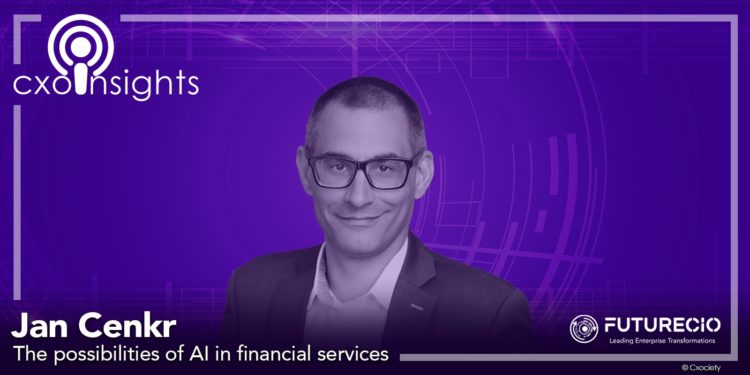The Gartner report, Emerging Tech Impact Radar: Artificial Intelligence in Banking, reveals that 67% of banking institutions (surveyed) are currently using artificial intelligence in their operations.
Use cases for adopting AI include enhancing automation efforts and driving efficiency, improving customer service, reducing operating costs, boosting data analytics to support data-driven decision-making, and personalisation.
When OpenAI launched ChatGPT back in November 2022, little did we anticipate the interests the technology would draw from across the spectrum of industries, users and regulators. Beyond the use of ChatGPT to enable more human-like virtual assistants, what lies ahead for financial institutions in the journey towards the democratisation of AI?
Jan Cenkr, group chief information officer of Home Credit, says financial services have evolved over the last few decades with technological advancements such as mobile phones.
"Now, with big data and artificial intelligence, the biggest transformation has been enhanced data model scoring which allows companies to use personalised information to develop better products for customers," said Cenkr.
He cited another benefit in the field collection of data for call centres, where companies can use automation to introduce better optimisation and higher-quality human-like chatbots or voice bots into the process.
The most promising use cases of AI and big data in financial services
Jan Cenkr: One use case is in data collection for call centre activities. Many financial services companies, particularly in Asia, use field collectors to ensure data is collected from the right people in the shortest time. Big data or AI can allow field collectors to better plan their transportation routes to visit more people in a day.
Another area is in using data for better product targeting based on customer behaviour. This not only helps companies to expand their product offerings but also benefits customers who now can discover products they have never used before.
Home Credit and its AI journey
Jan Cenkr: Home Credit is a multinational financial institution operating across multiple countries and serving millions of customers. In Asia, we offer financing for underserved consumers, including for mobile phones and other consumer goods, and provide cash loans as well.
We have recently launched a new mobile application for all our markets and already have millions of subscribers to the app. We have also introduced educational programmes on financial literacy to ensure that our customers understand what they are getting themselves into.
Digital adoption among Asians and Europeans
Jan Cenkr: Legislation is a key obstacle when it comes to data usage and digitalisation. Europe is not too far behind in data protection and Asian markets are catching up quickly. The Philippines is probably the most advanced in digital adoption among emerging markets, while many gaps relating to legislation exist in other markets.
Another interesting point is customer behaviour. As a Czech-based company operating in Europe, it took us a while to familiarise ourselves with the mindsets of Asian customers as we expanded rapidly over the past 15 years to the region. There are vast differences in consumer habits across markets.
Best practices when adopting technology
Jan Cenkr: Firstly, good cybersecurity practices are important in ensuring we keep our data safe. The legislation for data privacy in Asia is slightly different in Europe.
Particularly with big data or AI, where we congregate large amounts of data into one place for data modelling, access to data is something that needs to be guarded very carefully.
Another suggestion is to focus on one or two digital transformation initiatives at a time instead of many. Not all ideas are going to work. Some could become goldmines while others could be rubbish. Take small steps and make it a habit to secure your data.
Accelerating tech adoption despite regulation
Jan Cenkr: Legislation is here and we have to live with it. We frequently engage in dialogues with governments and regulatory bodies to explain the benefits of emerging technologies and help them trial their legislation to achieve mutual benefits.
One example which we have seen in some markets is a global regulatory body for mobile phone numbers. This not only helps us identify users with their registered information but also helps governments to speed up their digital agenda.
We welcome open dialogue not only with regulators but also with financial institutions and other players that will stand to benefit from innovation.
The growing influence of GenAI and LLMs
Jan Cenkr: ChatGPT has been on everyone’s radar and the company has been making improvements to drive the software’s efficiency.
Home Credit has been using chatbots and voice bots in our call centres to communicate with customers and manage costs. These bots have become humanised over the years. For instance, our first voice bot had a robotic voice and customers felt that they didn’t want to talk to it.
These days, technology has evolved so much that one could find it difficult to distinguish between a human and a bot. That will keep evolving and innovations will be launched over time.
Balancing emerging technologies, evolving regulations and customer preferences
Jan Cenkr: It is a constant change to a certain degree. When I first started, it seemed like IT was in a basement doing things and nobody wanted to talk to them. These days, it is completely different.
The IT team is part of any business discussion, be it product, strategy or marketing. Everything involves technology these days.

"Our role as a CIO is to help the business navigate technological change and discuss adoption strategies and their impact on customers. The border between IT and business has blurred because IT needs to become closer to the business to help a company achieve its goals."
Jan Cenkr
Advice for other CIOs in driving digital adoption
Jan Cenkr: This is a tough question because we have had lots of failures along the way as well. I think one piece of advice is to just keep trying and keep going. Take small steps forward and pick one area to focus on at one time.
This is because if you try to digitalise everything at the same time, it is a road to disaster. We have seen that not only in financial institutions but in other companies as well. So my advice is don't be afraid. Just go for it.
Click on the PodChat player to hear Cenkr go deep on the possibilities of AI in financial services.
- How has artificial intelligence and big data transformed financial services?
- From your experience, what are the most promising use cases for artificial intelligence and big data when it comes to the provision of financial services?
- What are the differences you see between consumers in Asia and Europe in terms of digital adoption? Why do you think this is the case?
- Are there any best practices that financial services companies should adopt in their use of AI?
- Do you see regulation impeding the adoption of emerging technologies like AI?
- With the rise of ChatGPT and large language models (LLM), how do you think AI will continue to transform the finance industry?
- How do you think the role of a CIO has evolved to support business priorities?
- What is your advice for CIOs and C-suite executives who are looking to drive digital adoption in Asia’s emerging markets?





